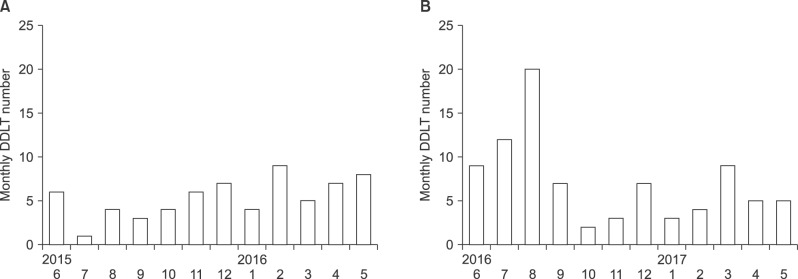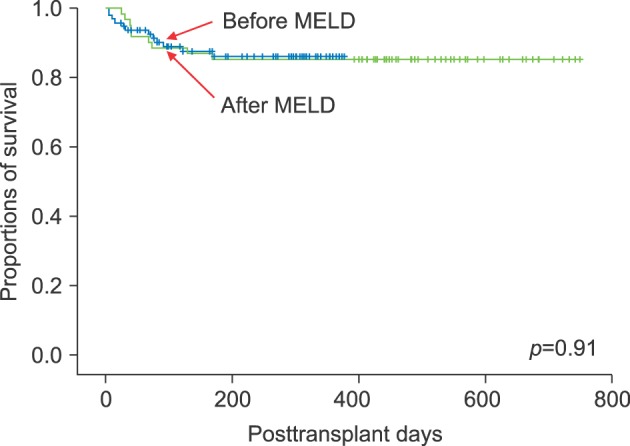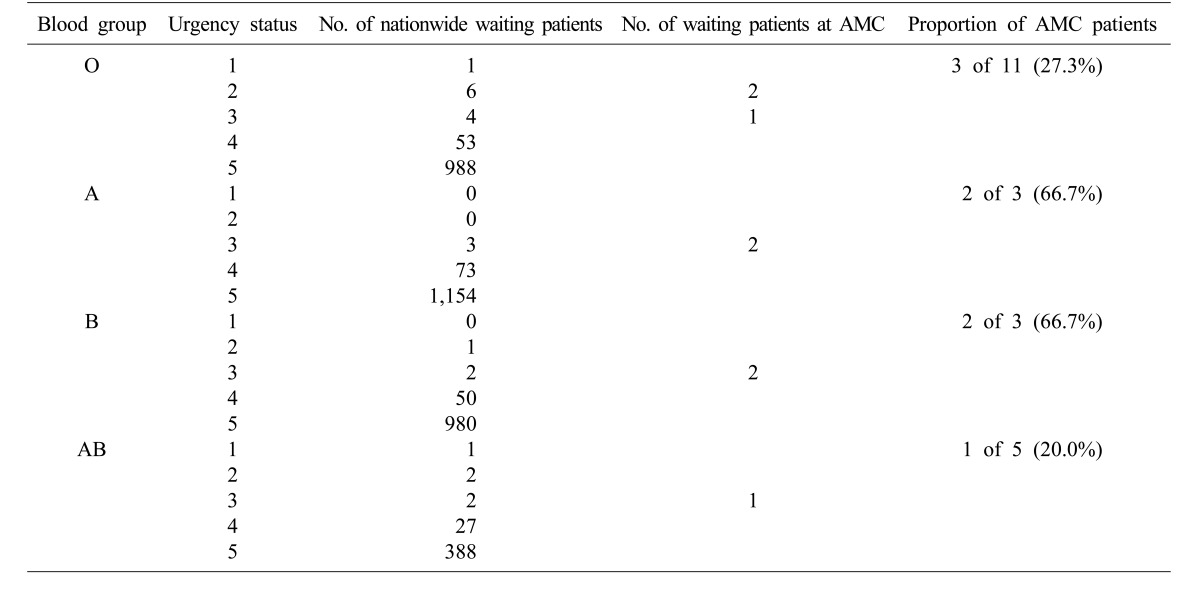Abstract
Methods
We analyzed changes in volumes and outcomes of deceased donor liver transplantation (DDLT) for 1 year before and after introduction of MELD scoring at Asan Medical Center.
Results
There were 64 cases of DDLT in 1 year before MELD introduction and 106 in 1 year after MELD introduction, an increase of 65%. The volume of DDLTs abruptly increased during first 3 months, but then returned to its usual level before MELD introduction, which indicated 3-month depletion of accumulated recipient pool with high MELD scores. The number of pediatric DDLT cases increased from 3 before MELD introduction to 11 after it, making up 21.4% and 47.8% of all cases of pediatric liver transplantation, respectively. The number of cases of retransplanted DDLTs increased from 4 to 27, representing 6.3% and 25.5% of all DDLT cases, respectively. The number of status 1 DDLT cases increased from 5 to 12, being 7.8% and 11.3% of all cases. Patient survival outcomes were similar before and after MELD introduction.
Conclusions
The number of DDLTs temporarily increased after adoption of MELD scoring due to accumulated recipient pool with high MELD scores. The numbers of retransplanted and pediatric DDLT cases significantly increased. Patient survival in adult and pediatric DDLT was comparable before and after adoption of MELD scoring. These results imply that Korean MELD score-based allocation system was successfully established within its first year.
Optimization of allocation of the organs of deceased donors is a matter of concern for patients on the waiting list for liver transplantation (LT), as it can reduce patient mortality and wait times until LT and also increase the number of LT cases.
In Korea, a nationwide deceased donor liver graft (DDLG) allocation system was put into place in February 2000 after the establishment of the Korean Network for Organ Sharing (KONOS), whose allocation system was based on the Child-Turcotte-Pugh (CTP) score: KONOS is the Korean modification of the United Network for Organ Sharing (UNOS) system.12 There were two serious issues in this old system. One was no relisting was permitted after passing 2-week priority allocation for status 1 and 2A patients. The other was that the criteria for status 2A were too widely defined.
Although the numbers of deceased donors was gradually increasing, there is still a severe shortage of liver organ considering the demand for LT, thus a more optimized allocation system became necessary. An allocation system based on the Model for End-stage Liver Disease (MELD) score was instituted in June 2016.345 During a 2-year preparatory period, detailed regulations on the allocation system based on MELD scoring were established for use in the Korean context.
This study analyzed the changes in volumes and outcomes of deceased donor liver transplantation (DDLT) cases for 1 year before and after the introduction of MELD scoring at a high-volume LT center in Korea.
The present study was a retrospective analysis using single-institution LT data from Asan Medical Center. There were two study periods. The first encompassed the period from June 2015 to May 2016, a 1-year study period preceding the introduction of MELD scoring. The second period encompassed the period from June 2016 to May 2017, a 1-year study period following the introduction of MELD scoring. We analyzed and compared the changes in volumes and outcomes of DDLTs during these two study periods. The institutional review board of our institution approved this study.
The Korean liver allograft allocation system had been based on the UNOS system, using CTP scoring, which included status 1 (acute liver failure and early graft failure), status 2A (acute-on-chronic liver failure), status 2B, status 3, and status 7. Status 1 and 2A had a priority allocation period of 2 weeks, and relisting was not permitted.
To replace the CTP score-based allocation system in Korea, two government-supported simulation studies were performed for introduction of MELD score-based allocation system. According to these precedent studies, we set the priority status according to the MELD scores to establish customized modification of the MELD score-based allocation system that suited the actual situation in Korea.
A new allocation system based on MELD scoring was put into place in June 2016. The MELD score is calculated using the following formula: “9.57×loge (creatinine, mg/dl)+3.78×loge (total bilirubin, mg/dl)+11.2×loge (INR)+6.43”. This produces five statuses, as follows: status 1 (acute liver failure and early graft failure), status 2 (MELD score 38-40, equivalent to KONOS status 2A), status 3 (MELD score 31-37), status 4 (MELD score 21-30), and status 5 (MELD score ≤20). Patients with hepatocellular carcinoma (HCC) within the Milan criteria receive an additional 4–5 points if their MELD score is ≤20. Pediatric End-stage Liver Disease (PELD) scoring is used for patients ≤12 years old.
The incidence variables were compared using the chi-square test and Fisher's exact test. Patient survival curves were estimated using the Kaplan-Meier method and compared using the log-rank test; p-values <0.05 were considered statistically significant. Statistical analyses were performed using SPSS version 22 (IBM, NY).
There were 64 DDLT cases during the year before the introduction of MELD scoring, and 106 during the year after it, an increase of 65%. The DDLT volume abruptly increased in the first 3 months after the introduction of MELD scoring, but returned thereafter to what had been its usual volume before MELD introduction (Fig. 1). The primary cause of such an abrupt increase in our institution was accumulation of the recipient pool with high MELD scores (Table 1) because previous CTP score-based allocation system did not permit relisting after passing 2-week period of priority allocation.
During the study periods, there were 329 cases of living donor LT (LDLT) in the year before MELD introduction and 357 during the year after it. Thus, DDLT was 16.3% (64 of 393) and 22.9% (106 of 463) of the total LT volume before and after MELD introduction, respectively (Fig. 2).
Pediatric DDLT cases increased from 3 to 11 from before to after MELD introduction, representing 3 of 14 (21.4%) and 11 of 23 (47.8%) pediatric LT cases, respectively (p=0.16). Retransplant DDLT cases increased from 4 of 64 (6.3%) to 27 of 106 (25.5%) DDLT cases (p=0.002). Status 1 DDLT cases increased from 5 of 64 (7.8%) to 12 of 106 (11.3%) DDLT cases (p=0.46). The distribution of MELD scores is shown in Fig. 3. The percentage of patients with MELD scores of 31-37 (new status 3) was significantly greater after MELD introduction (p=0.006).
In adult recipients, 3-month patient mortality rates were 11.5% and 9.9% before and after MELD introduction, respectively (Fig. 4) (p=0.91). In pediatric recipients, there were no cases of patient mortality (0%; 0 of 3) before MELD introduction and one case (9.1%; 1 of 11) after it (p=1.000).
The demand for LT remains high in Korea, primarily because of the high prevalence of hepatitis B virus infection and HCC, despite active treatment and prevention of HBV.456 LDLT was developed because of lack of deceased donors. The number of deceased donors has recently exceeded 10 per million population (PMP).3 As the number of deceased donors has increased, the ratio of LDLT to total LT volume has begun to decrease.457 In current practice, most DDLGs are allocated to patients with an urgent status. Thus, the optimal sharing of DDLG has increased in importance.
To effectively allocate DDLG in Korea, the introduction of MELD scoring was seriously considered, and it was finally put into place after two government-supported simulation studies. Because it may not be possible to effectively allocate DDLG where there is a low incidence of deceased donors, a customized modification of the MELD score-based allocation system that suited the actual situation in Korea became required. First, status 2 was set at MELD score 38–40, when the estimated incidence of deceased donors reached 10 PMP. This idea was derived from the share 35 policy, created to support increased numbers of transplants, fewer discards, and lower waitlist mortality.89 We anticipated that statuses 1 and 2 would make up more than half of all DDLT cases. Second, status 3 was set for MELD scores of 31–37. The probability of the allocation of DDLG varied according to the fluctuating daily incidence of deceased donors. Third, the additional points given to HCC patients were intentionally set to be negligibly low, because of the very high number of HCC patients awaiting LT. In fact, half of adult LDLT recipients in our institution have HCC.47
Just after the new MELD-based allocation system was implemented, we experienced a large increase in monthly DDLT volumes for 3 months, followed by a return to the usual volumes. This phenomenon indicates that the accumulated pool of recipient candidates with very high MELD scores was rapidly depleted in the first 3 months. At the first day of July 2016, there were 22 nationwide waiting patients belonging to the statuses 1–3, and 8 (36.4%) of them were enrolled from our institution (Table 1). These data indicate that one-third of nationwide DDLGs at that day would be allocated to our waiting patients. After depletion of such patient pool with very high MELD scores, such a concentration effect disappeared.
A large increase in retransplant DDLT cases would also explain this phenomenon, where patients were not able to receive DDLG under the previous CTP-based KONOS allocation system.10
An increase in pediatric DDLT cases was noticeable in the present study, but this might not be directly associated with the MELD/PELD scoring system. In fact, recent widening of donor indications for liver splitting appears to have contributed to the increase in pediatric DDLT cases.1112
After the MELD score-based allocation system was introduced, the percentages of LT recipients with very high MELD scores greatly increased, as reflected in prolonged post-transplant stays in the intensive care unit. Despite these difficulties, patient mortality rates remained unchanged, implicating that the MELD score per se is not an irreversible factor for poor post-transplant prognosis.1314
Several studies have summarized the results following the introduction of MELD scoring in DDLG allocation. Freeman et al. reported that the MELD/PELD score-based system in the United States has been associated with reduced registrations and improved transplantation rates without increased mortality rates for individual groups of waiting candidates or changes in early transplant survival rates.15 Ben-Haim et al.16 concluded that MELD is valid in Israel and superior to the CTP score for predicting waiting list mortality. Although longer waiting times due to organ scarcity are a key factor, death rates in mid-range MELD groups indicate that further audit of the care of patients with end-stage liver disease is necessary. Castro et al.17 found that patient survival on the waiting list for LT had not changed 1 year after the introduction of MELD scoring in Brazil. The collective review of Chaib et al.18 indicated that MELD scoring significantly improved short-term survival for the sickest patients on the waiting list for LT; additionally, it did not have a significant impact on survival for the healthiest patients.
The results of our present study indicate that the Korean allocation system based on MELD scoring was successfully established within a few months at our institution. Our present study is the first report regarding Korean MELD scoring system. We believe that successful settlement is already achieved for the nationwide Korean base. It is difficult to effectively and equally allocate DDLG; thus, continuous refinement of the detailed rules for DDLG allocation is mandatory.19
The present study had several limitations of note. It was a single-center study, so multicenter or nationwide studies must be performed to validate our results. Waiting list mortality was also not assessed.
In conclusion, the number and percentage of DDLTs increased at our institution after implementation of an allocation system based on MELD scoring in Korea. Such increase was a temporary phenomenon primarily due to accumulated recipient pool with high MELD scores in a high-volume LT center. More than 80% of recipients were statuses 1 to 3. Retransplant and pediatric DDLT cases significantly increased. The survival outcomes of DDLT recipients did not change after the adoption of MELD scoring. These results indicate that new Korean allocation system based on MELD scoring was successfully established within its first year.
ACKNOWLEDGEMENTS
This study was supported by the Basic Science Research Program through the National Research Foundation of Korea (NRF) funded by the Ministry of Science, ICT and Future Planning (Grant No 2015R1A2A2A04007141). There were no authors who have conflict of interest to disclose.
References
1. Bollinger RR, Cho WH. Organ allocation for transplantation in the USA and Korea: the changing roles of equity and utility. Yonsei Med J. 2004; 45:1035–1042. PMID: 15627294.

2. Hwang S, Ahn CS, Kim KH, Moon DB, Ha TY, Song GW, et al. Survival rates among patients awaiting deceased donor liver transplants at a single high-volume Korean center. Transplant Proc. 2013; 45:2995–2996. PMID: 24157021.

3. Min SI, Ahn C, Han DJ, Kim SI, Chung SY, Lee SK, et al. To achieve national self-sufficiency: recent progresses in deceased donation in Korea. Transplantation. 2015; 99:765–770. PMID: 25226175.
4. Lee SG, Moon DB, Hwang S, Ahn CS, Kim KH, Song GW, et al. Liver transplantation in Korea: past, present, and future. Transplant Proc. 2015; 47:705–708. PMID: 25891715.

5. Jung BH, Hwang S, Song GW, Jung DH, Ha TY, Park GC, et al. Updated status of deceased-donor liver graft allocation for high-urgency adult patients in a Korean high-volume liver transplantation center. Transplant Proc. 2015; 47:580–583. PMID: 25891690.

6. Korean Association for the Study of the Liver. KASL clinical practice guidelines: management of chronic hepatitis B. Clin Mol Hepatol. 2016; 22:18–75. PMID: 27044762.
7. Moon DB, Lee SG, Hwang S, Kim KH, Ahn CS, Ha TY, et al. Toward more than 400 liver transplantations a year at a single center. Transplant Proc. 2013; 45:1937–1941. PMID: 23769078.

8. Massie AB, Chow EK, Wickliffe CE, Luo X, Gentry SE, Mulligan DC, et al. Early changes in liver distribution following implementation of Share 35. Am J Transplant. 2015; 15:659–667. PMID: 25693474.

9. Washburn K, Harper A, Baker T, Edwards E. Changes in liver acceptance patterns after implementation of Share 35. Liver Transpl. 2016; 22:171–177. PMID: 26437266.

10. Hwang S, Ahn CS, Kim KH, Moon DB, Ha TY, Song GW, et al. Liver retransplantation for adult recipients. Korean J Hepatobiliary Pancreat Surg. 2013; 17:1–7. PMID: 26155206.

11. Oh SH, Kim KM, Kim DY, Song SM, Kim T, Hwang S, et al. Clinical experience of more than 200 cases of pediatric liver transplantation at a single center: improved patient survival. Transplant Proc. 2012; 44:484–486. PMID: 22410052.

12. Cuenca AG, Kim HB, Vakili K. Pediatric liver transplantation. Semin Pediatr Surg. 2017; 26:217–223. PMID: 28964477.

13. Moon DB, Lee SG, Kang WH, Song GW, Jung DH, Park GC, et al. Adult living donor liver transplantation for acute-on-chronic liver failure in high-model for end-stage liver disease score patients. Am J Transplant. 2017; 17:1833–1842. PMID: 28097804.

14. Yadav SK, Saraf N, Saigal S, Choudhary NS, Goja S, Rastogi A, et al. High MELD score does not adversely affect outcome of living donor liver transplantation: Experience in 1000 recipients. Clin Transplant. 2017; 31:DOI: 10.1111/ctr.13006.

15. Freeman RB, Wiesner RH, Edwards E, Harper A, Merion R, Wolfe R. Results of the first year of the new liver allocation plan. Liver Transpl. 2004; 10:7–15. PMID: 14755772.

16. Ben-Haim M, Carmiel M, Katz P, Shabtai E, Oren R, Nakache R. Is the model of end-stage liver disease (MELD) valid in Israel? A critical analysis of liver transplant waiting list mortality. Isr Med Assoc J. 2006; 8:605–609. PMID: 17058408.
17. Castro RS, Deisanti D, Seva-Pereira T, Almeida JR, Yamanaka A, Boin IF, et al. Survival before and after model for end-stage liver disease score introduction on the Brazilian liver transplant waiting list. Transplant Proc. 2010; 42:412–416. PMID: 20304153.

18. Chaib E, Figueira ER, Brunheroto A, Gatti AP, Fernandes DV, D'Albuquerque LA. Does the patient selection with MELD score improve short-term survival in liver transplantation? Arq Bras Cir Dig. 2013; 26:324–327. PMID: 24510043.
19. Asrani SK, Kim WR. Model for end-stage liver disease: end of the first decade. Clin Liver Dis. 2011; 15:685–698. PMID: 22032523.

Fig. 1
The monthly incidences of deceased donor liver transplantation (DDLT) volumes during 1 year before (A) and after (B) MELD score application.

Fig. 2
Comparison of the annual liver transplantation (LT) volume before and after MELD score application. DD, deceased donor; LD, living donor.

Fig. 3
Distribution of patients with MELD scores before and after the introduction of MELD scoring, not including status 1.





 PDF
PDF ePub
ePub Citation
Citation Print
Print




 XML Download
XML Download